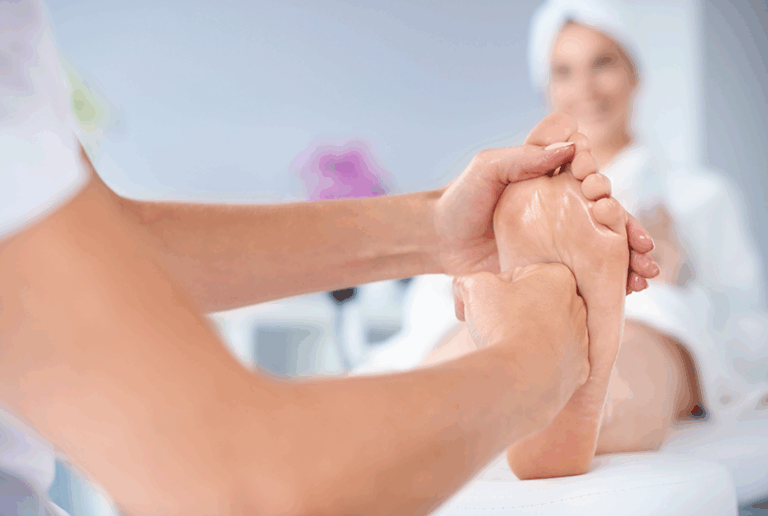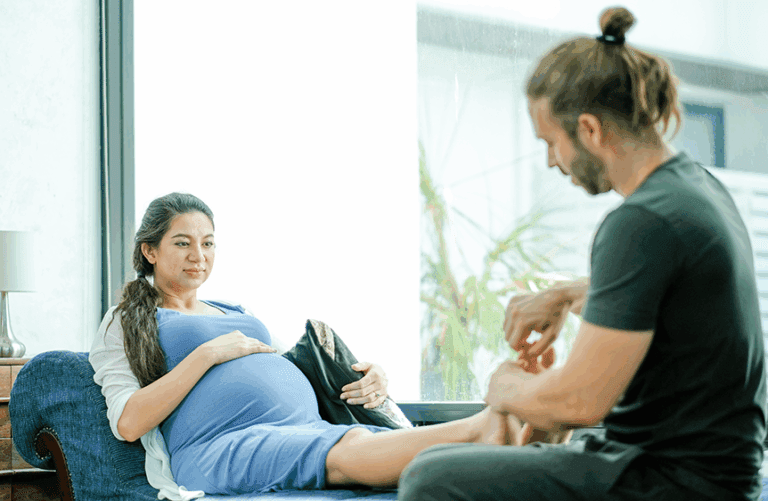Yes—massage in pregnancy is generally safe when provided by a trained therapist using pregnancy-specific positioning and gentle techniques. Side-lying with cushions protects circulation and spinal alignment. Light-to-moderate pressure is used, avoiding deep abdominal work and contraindicated points. Screening checks trimester, medical history, and red flags (e.g., unexplained bleeding, preeclampsia signs, suspected DVT). Neutral oils are preferred; certain essential oils are avoided. Sessions emphasize comfort, communication, and monitoring. Further details explain benefits by trimester, precautions, and what to expect at appointments.
Understanding Prenatal Massage and Its Safety
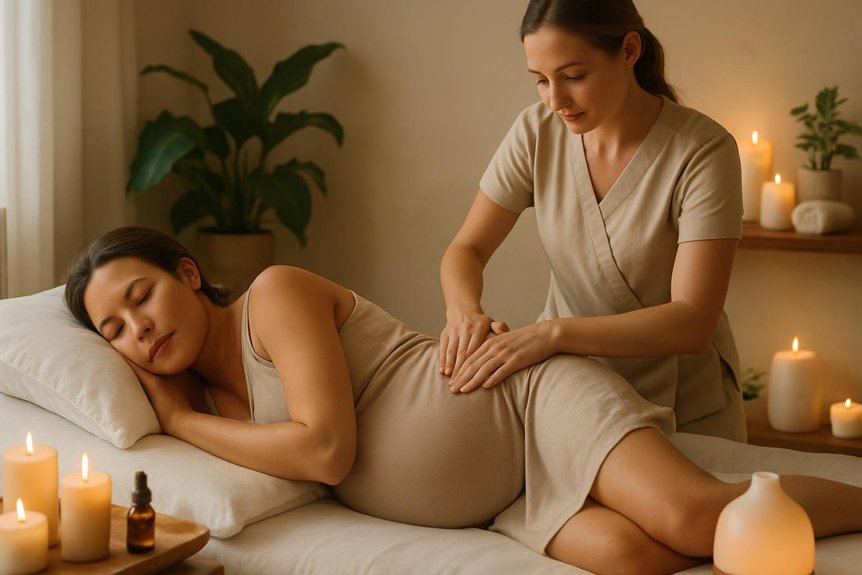
Pregnancy massage, when delivered by trained therapists using appropriate techniques, is considered safe for most healthy pregnancies and can help reduce musculoskeletal pain, swelling, stress, and sleep disturbance.
At Spa & Massage, therapists complete specialist training and follow evidence-based protocols: side-lying positioning with supportive cushions, light-to-moderate pressure, and careful pacing to maintain comfort and circulation. Medical history, trimester stage, and any red flags (such as unexplained bleeding, preeclampsia, or severe nausea) are screened before treatment, and consent is reaffirmed throughout.
Clinically, massage may modulate autonomic tone, ease myofascial tension, and support venous and lymphatic return.
In our clinics, neutral, hypoallergenic oils are used, avoiding abdominal compression and endangerment sites. Clients are encouraged to communicate preferences, hydrate, and rise slowly after sessions.
With appropriate assessment and technique, risks remain low. Some therapists may also incorporate deep tissue massage techniques with caution, ensuring that intensity is adjusted for pregnancy and remains within safe parameters.
Benefits for Each Trimester
Across pregnancy, the goals and techniques of massage shift to match physiological changes.
In the first trimester, careful, shorter sessions may help mitigate stress and nausea.
By the second trimester, targeted work can safely ease muscular tension and improve sleep.
In the third trimester, side-lying positioning and gentle techniques support low-back, hip, and pelvic comfort while promoting relaxation before birth.
First Trimester Considerations
Early on, the first trimester calls for a cautious, comfort‑led approach grounded in current prenatal guidance. Spa & Massage advises gentle, adapted treatments that prioritise rest, nausea relief, and stress reduction while avoiding deep abdominal pressure and strong trigger‑point work. Side‑lying or semi‑reclined positioning supports circulation and eases breast tenderness.
Light to moderate strokes to the back, neck, scalp, hands, and feet can reduce tension and promote sleep.
Therapists at Spa & Massage screen for bleeding, severe nausea, abdominal pain, fever, or prior complications; when present, they recommend medical clearance before treatment.
In our clinics, unscented or very mild, pregnancy‑safe oils are used, and heat is kept moderate.
Sessions are shorter initially, with clear stop‑signals.
Aftercare emphasises hydration, small frequent meals if nauseous, and unrushed progressions to standing.
Second Trimester Benefits
By the second trimester, many expectant clients experience steadier energy and improved comfort, making this an ideal window for therapeutic, pregnancy‑adapted massage. Evidence suggests massage can reduce low‑back and pelvic discomfort, improve sleep quality, and modulate stress hormones, supporting a calmer autonomic tone.
Circulatory benefits are notable; gentle, rhythmic strokes can ease ankle and hand swelling without compromising safety.
At Spa & Massage, therapists position clients side‑lying with supportive bolsters to protect the abdomen and optimize venous return. Pressure is moderate, avoiding contraindicated points and deep abdominal work.
Fragrance‑free or mild, pregnancy‑safe oils are used to respect sensitive skin. Clients often report clearer breathing, lighter legs, and softened myofascial tension through hips and shoulders, fostering easeful movement and quiet reassurance between appointments.
Third Trimester Support
As pregnancy advances into the third trimester, massage can be refined to address late‑stage demands on the musculoskeletal and circulatory systems while maintaining strict safety parameters. Evidence supports side‑lying positioning with careful bolstering to reduce vena caval compression, ease lumbar load, and stabilise pelvic joints.
Gentle myofascial and low‑to‑moderate pressure techniques to the back, hips, and gluteals may reduce sacroiliac strain, sciatica‑like symptoms, and rib cage tension. Targeted work for calves and feet can alleviate nocturnal cramping, while lymphatic‑informed strokes support ankle and hand swelling.
At Spa & Massage, therapists avoid deep abdominal work, strong trigger points, and supine positioning after mid‑pregnancy. Unscented or lightly scented pregnancy‑safe oils are used. Sessions emphasise breath pacing, thermoregulation, and shorter, more frequent treatments to promote sleep, comfort, and calm.
When to Avoid or Postpone a Session
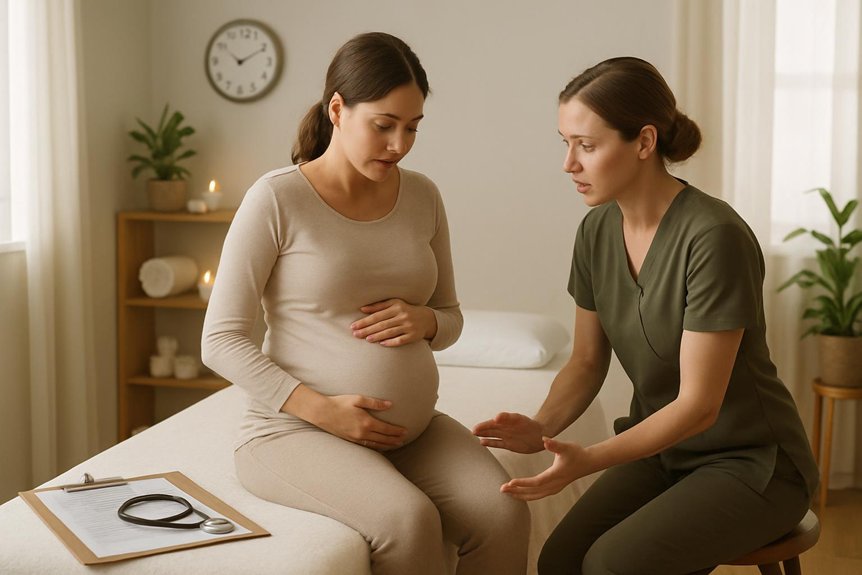
While prenatal massage is generally safe and beneficial, certain situations warrant postponing or seeking medical advice first.
Individuals should delay a session if they have unexplained vaginal bleeding, severe abdominal pain, reduced fetal movements, fever, vomiting, signs of preeclampsia (severe headache, visual changes, sudden swelling), suspected deep vein thrombosis, placenta previa with bleeding, or preterm labour symptoms.
Recent illness, COVID-19, or contagious skin infections also merit rescheduling.
After in-vitro fertilisation or within the first trimester following miscarriage, risk discussions with a healthcare professional are recommended.
Postpone massage within 24–48 hours of significant medical procedures or new medications affecting clotting.
If unsure, Spa & Massage therapists recommend a brief phone triage and, when needed, written clearance from a midwife or obstetrician to ensure safety and peace of mind.
How We Adapt Techniques for Expecting Mothers
Safety considerations inform every step of care, and once suitability is confirmed, Spa & Massage adapts techniques to pregnancy physiology. Therapists moderate pressure, focusing on gentle, rhythmic strokes that ease muscular tension without provoking vascular or uterine strain. They avoid deep work over the abdomen and modify intensity across the lower back, hips, and calves, where circulation patterns change in pregnancy.
In our clinics, neutral, unscented oils are used unless a client prefers pregnancy-safe aromatherapy; any essential oils are selected conservatively and patch-tested when appropriate.
Therapists support lymphatic return with light, directed strokes to reduce puffiness in hands, feet, and ankles. They also pay careful attention to breathing cadence, cueing slow, nasal breaths to downregulate the stress response.
Communication is continuous—comfort, warmth, and pressure are checked and adjusted throughout.
Side-Lying Positioning and Cushioning We Use
At Spa & Massage, pregnancy sessions begin with a safe side‑lying setup that maintains neutral spinal alignment and reduces pressure on the abdomen and lower back. Therapists use adjustable wedge pillows, knee bolsters, and soft supports to stabilise hips and shoulders, optimise circulation, and keep joints comfortably aligned.
Cushioning is tailored to trimester and body shape, with continuous monitoring to guarantee comfort and clinical safety throughout the treatment.
Safe Side-Lying Setup
A side‑lying position is the cornerstone of safe, comfortable prenatal massage, and therapists at Spa & Massage apply a structured setup to protect maternal and fetal well‑being. They align the ears, shoulders, hips, and ankles, maintaining a neutral spine to reduce sacroiliac and lumbar load.
The head rests in slight flexion to ease cervical tension and promote calm breathing. The underside shoulder is brought forward to avoid brachial plexus compression, while the upper arm is supported to prevent strain.
They angle the torso about 20–30 degrees to optimise venous return and minimise aortocaval pressure. Hips and knees are gently flexed to relax the psoas and pelvic floor.
Draping is secure yet soft, preserving warmth and intimacy. Adjustments are made continuously, responding to breath, comfort cues, and tissue feedback.
Cushions for Pregnancy
Thoughtful cushioning underpins safe, effective prenatal massage in the side‑lying position. At Spa & Massage, therapists use adjustable wedges, long body pillows, and knee bolsters to maintain neutral spinal alignment, minimise hip strain, and reduce uterine pressure—an approach consistent with perinatal guidelines.
A firm wedge supports the upper torso to ease breathing; a body pillow cradles the bump without compressing it; a soft bolster between knees and ankles aligns the pelvis and lowers lumbar load. Head and shoulder cushions are adjusted to keep the neck neutral and the shoulders relaxed.
Pressure points are monitored throughout, and cushions are repositioned if tingling, reflux, or breathlessness arise. Hypoallergenic, wipe‑clean covers are used, and cushioning height is tailored to each trimester, promoting comfort, safe circulation, and deep, restful ease.
Oils, Aromatherapy, and What’s Safe in Pregnancy
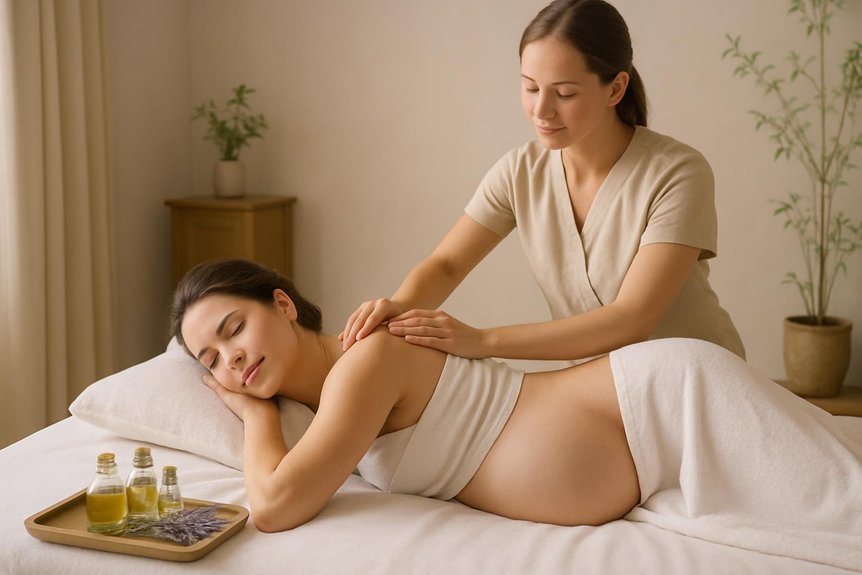
Which oils are appropriate in pregnancy, and how can aromatherapy be used safely?
Evidence supports the use of neutral, hypoallergenic carriers such as sweet almond, grapeseed, fractionated coconut, or jojoba; these minimize skin reactions and provide glide without excess scent.
In Spa & Massage clinics, therapists typically use low-dilution essential oils (usually 0.5–1%) only after screening for trimester, sensitivities, and medical history.
Gentle options like lavender (for rest), mandarin or sweet orange (for light uplift), and ginger or peppermint (for queasiness, when tolerated) are used sparingly, avoiding the abdomen.
Oils commonly avoided include clary sage, rosemary, cinnamon, and camphor due to their uterotonic or sensitising potential.
Unscented massage is always available.
Ventilation, patch testing, and immediate cessation if irritation occurs are standard safety precautions.
Hydration after treatment and open communication about preferences help maintain comfort and closeness while staying clinically safe.
What to Expect at Your First Appointment
With oil choices clarified, the first appointment focuses on a structured, safety-first experience. At Spa & Massage, a therapist begins with a confidential health screen: gestational age, symptoms (nausea, swelling, pain), obstetric history, and clinician advice. Contraindications are checked, and preferred pressure, scents, and draping are noted.
Evidence-based positioning is used—typically side-lying with supportive bolsters to protect vena cava blood flow and pelvic comfort.
The therapist explains the sequence, gains consent, and stays in quiet communication, adjusting pressure in real time. Techniques favour slow myofascial and lymphatic strokes, avoiding deep work on the abdomen and known acupressure points.
Hygienic, hypoallergenic oils are applied sparingly. Sessions end with a brief check-in on comfort and any red flags, plus tailored booking guidance across trimesters at our London clinics.
Aftercare Tips for Comfort and Better Sleep
Following a prenatal massage, Spa & Massage advises simple aftercare to stabilise circulation, reduce soreness, and promote sleep.
Hydration is first: sipping water regularly supports lymphatic drainage and reduces post-massage heaviness.
Gentle movement helps—short, slow walks or pelvic tilts maintain blood flow without strain.
A warm (not hot) shower or compress eases residual tension.
For evening comfort, clients are encouraged to side‑lie with a pillow between knees and another supporting the bump; this aligns hips and lowers lumbar load.
Light stretching of calves, hips, and chest—30 seconds each—can reduce cramping and improve sleep quality.
In our clinics, unscented or mild lavender-infused oil is suggested for home self-massage of feet and shoulders.
Finally, avoid vigorous exercise and alcohol for 12–24 hours.
Booking a Prenatal Massage at Our London Clinics
Booking this massage at Spa & Massage is straightforward and designed around safety and comfort. Appointments can be arranged at six London clinics—Crouch End, Bayswater, Chiswick, Earl’s Court, Belsize Park, and Richmond—via online booking or by phone. Clients select trimester stage, preferred therapist, and session length to ensure appropriate care.
Before the visit, a brief health questionnaire screens for contraindications (e.g., unmanaged hypertension, preeclampsia, or recent complications).
On arrival, therapists confirm medical history and adapt positioning with side-lying support, wedges, and soft bolsters. In our clinics, neutral, hypoallergenic oils are used; pressure is adjusted to tolerance.
For reassurance, partners are welcome in the room when requested. Same-day and evening slots are often available. Questions are answered promptly, and follow-up advice is provided.
Conclusion
With careful screening, trimester-specific techniques, and side-lying support, prenatal massage can be both safe and soothing. Evidence suggests it may ease back and hip pain, swelling, and sleep disruption—when delivered by trained therapists using pregnancy-safe oils. Yet timing matters; certain symptoms warrant medical advice first. What unfolds in a first session is gentle, tailored, and monitored. Aftercare is simple, restorative. And the next step? Booking—when you’re ready—to feel tension soften, breath deepen, and rest finally arrive.

